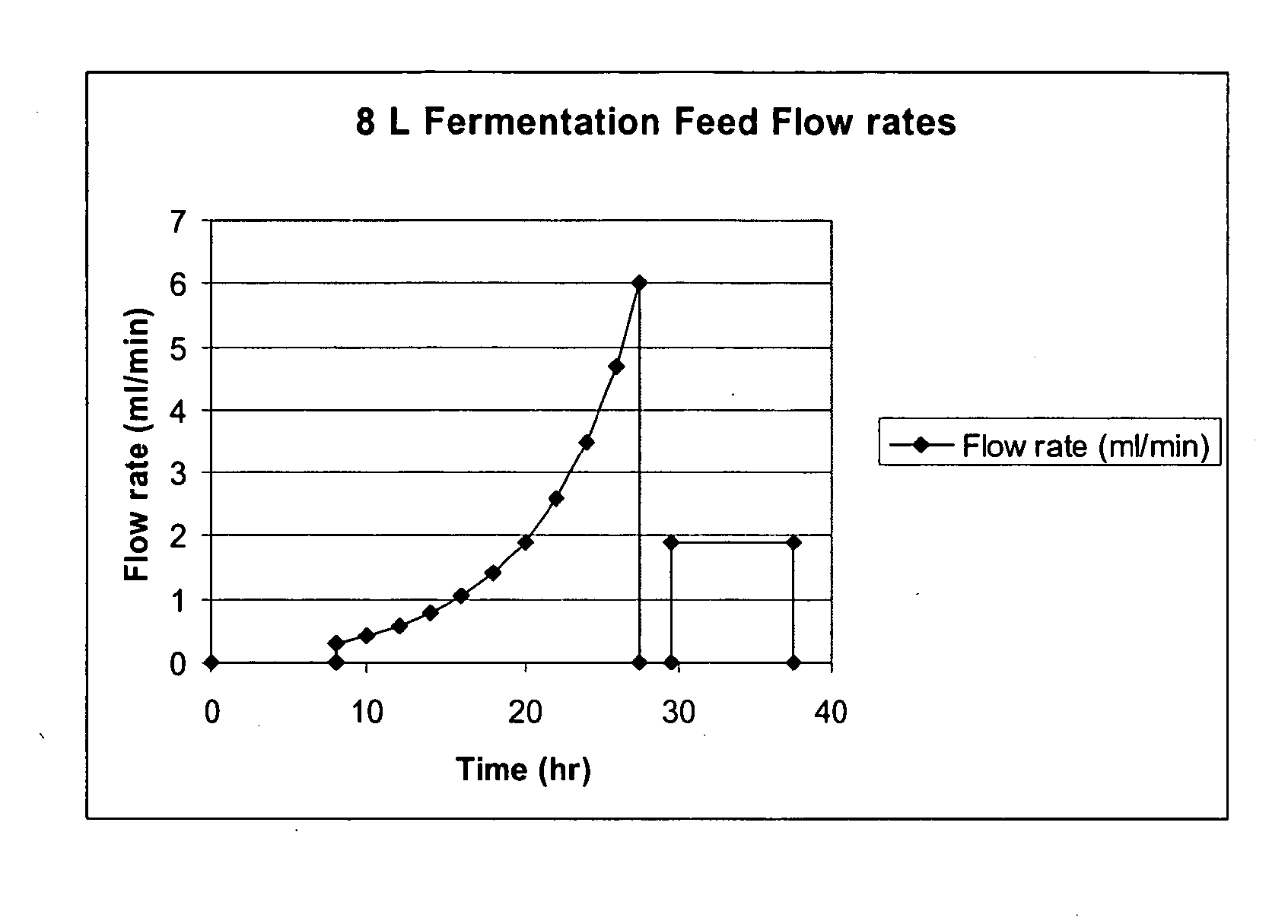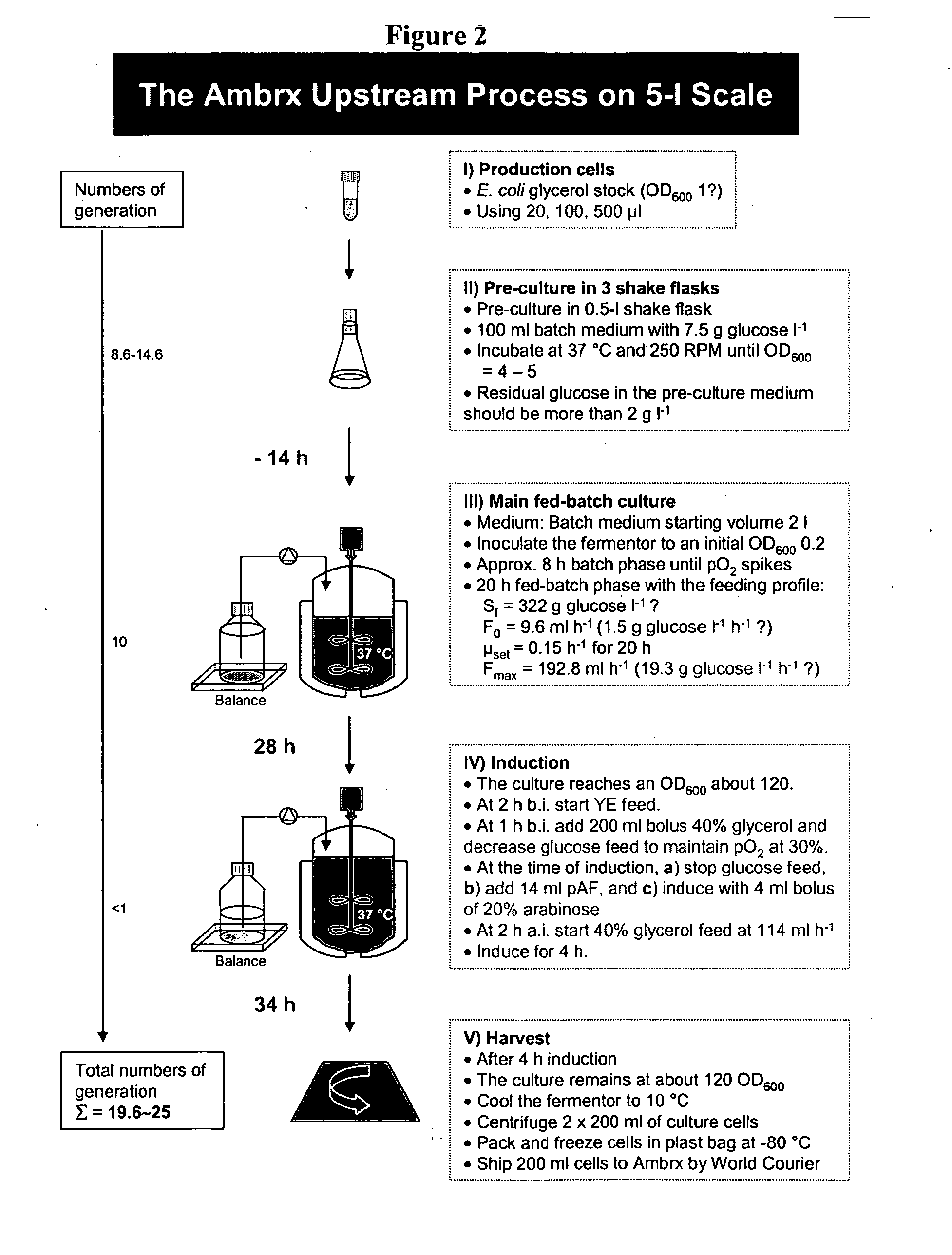Methods for Expression and Purification of Recombinant Human Growth Hormone
a technology of human growth hormone and recombinant human growth hormone, which is applied in the field of production, purification and isolation of substantially purified hgh, can solve the problems of short in vivo half-life of proteins, undesirable side effects, and decreased bioavailability and pain at the injection si
- Summary
- Abstract
- Description
- Claims
- Application Information
AI Technical Summary
Benefits of technology
Problems solved by technology
Method used
Image
Examples
example 1
[0415] This example describes expression methods used for hGH polypeptides comprising a non-natural amino acid. Host cells were transformed with constructs for orthogonal tRNA, orthogonal aminoacyl tRNA synthetase, and a polynucleotide encoding hGH polypeptide comprising a selector codon.
Preparation
[0416] Sterile base, 5.5 M potassium carbonate (0.5 L), was prepared and sterilized by steam or filtration. Sterile 25% v / v polyalkylene defoamer, such as Struktol J673 (0.1 L), was prepared and sterilized by steam. No acid was required. Concentrated feed medium (4 L, defined) was prepared and filter sterilized into a sterile feed tank or bioprocess bag.
[0417] The fermentor was set-up. It was sterilized with 3.91 L Base Salts solution. The fermentor was brought to the following conditions: temperature=37° C., pH=6.9, 1 VVM air. 0.092 L concentrated feed medium was added to the fermentor. 4 mL of 50 mg / mL kanamycin was added.
[0418] Solutions of glycerol and arabin...
example 2
hGH Purification, PEGylation, and hGH-PEG Purification Process Cytoplasmic Preparation from E. coli
[0432] An 850 gram bacterial cell pellet was resuspended in 2550 ml (3 volumes) of 20 mM TRIS, pH 8.5 lysis buffer to obtain a mixture that is 25% solid. Approximately four liters of culture in fermentation broth will yield this 850 gram bacterial pellet. The mixture was stirred at room temperature for 30-60 minutes, and the suspension was passed through the Microfluidizer processor twice with cooling at 15,000 psi. The lysate was centrifuged at 13,500×g for 45 minutes in a JA10 rotor at 4° C., and the supernatant was collected. Freshly prepared 0.1 M GSSG (FW 612.6) was added so that the molar ratio of GSSG to hGH was approximately 16. The combination was stirred to mix well, and the pH was adjusted to 7.2-7.4 with 1 M NaOH. After the mixture was stirred overnight at 4° C., it was diluted until its conductivity is 1.6-1.9 mS / cm with water. The sample wa...
example 3
hGH Purification, PEGylation, and hGH-PEG Purification Process Periplasmic Preparation from E. coli
1. Periplasmic Release of hGH
[0459] An 800 gram bacterial cell pellet obtained from approximately 4 liters of fermentation broth was resuspended in 3200 ml (4-volumes) of 4-6° C. PR Buffer (50 mM TRIS, 2 mM EDTA, 0.07% Triton X-100, pH 8.0; conductivity=3 mS / cm) to obtain 20% solid. After stirring the suspension at 4-6° C. for 1 hour, 150 ml of 8M urea was added to obtain a final urea concentration of 0.3 M. This suspension was then stirred at 4-6° C. for 1 hour. The suspension was centrifuged at 15,000×g for 25 minutes in a J20 rotor (Avanti J20 XP centrifuge—Beckman Coulter) at 4° C. The supernatant was collected, and its volume measured (approximately 3.4 L). The sample was designated as PRS with the date and lot number.
2. UF / DF (Ultrafiltration / Diafiltration) I
[0460] The following filter was used for this procedure: Sartorius Sartocon Slice 10 K Hydrosart cassette, 1000 cm2. ...
PUM
| Property | Measurement | Unit |
|---|---|---|
| molecular mass | aaaaa | aaaaa |
| MW | aaaaa | aaaaa |
| MW | aaaaa | aaaaa |
Abstract
Description
Claims
Application Information
 Login to View More
Login to View More - R&D
- Intellectual Property
- Life Sciences
- Materials
- Tech Scout
- Unparalleled Data Quality
- Higher Quality Content
- 60% Fewer Hallucinations
Browse by: Latest US Patents, China's latest patents, Technical Efficacy Thesaurus, Application Domain, Technology Topic, Popular Technical Reports.
© 2025 PatSnap. All rights reserved.Legal|Privacy policy|Modern Slavery Act Transparency Statement|Sitemap|About US| Contact US: help@patsnap.com



